Business Report: Unilever and Tesco Distribution Issue
VerifiedAdded on 2023/01/04
|8
|2018
|88
AI Summary
This business report analyzes the distribution issue between Unilever and Tesco, identifies the underlying problem of decreased demand, and provides solutions to improve sales and customer satisfaction. The report discusses the importance of customer relationship management and market positioning in resolving the issue. It also highlights the strengths, weaknesses, and implications of the proposed solutions.
Contribute Materials
Your contribution can guide someone’s learning journey. Share your
documents today.
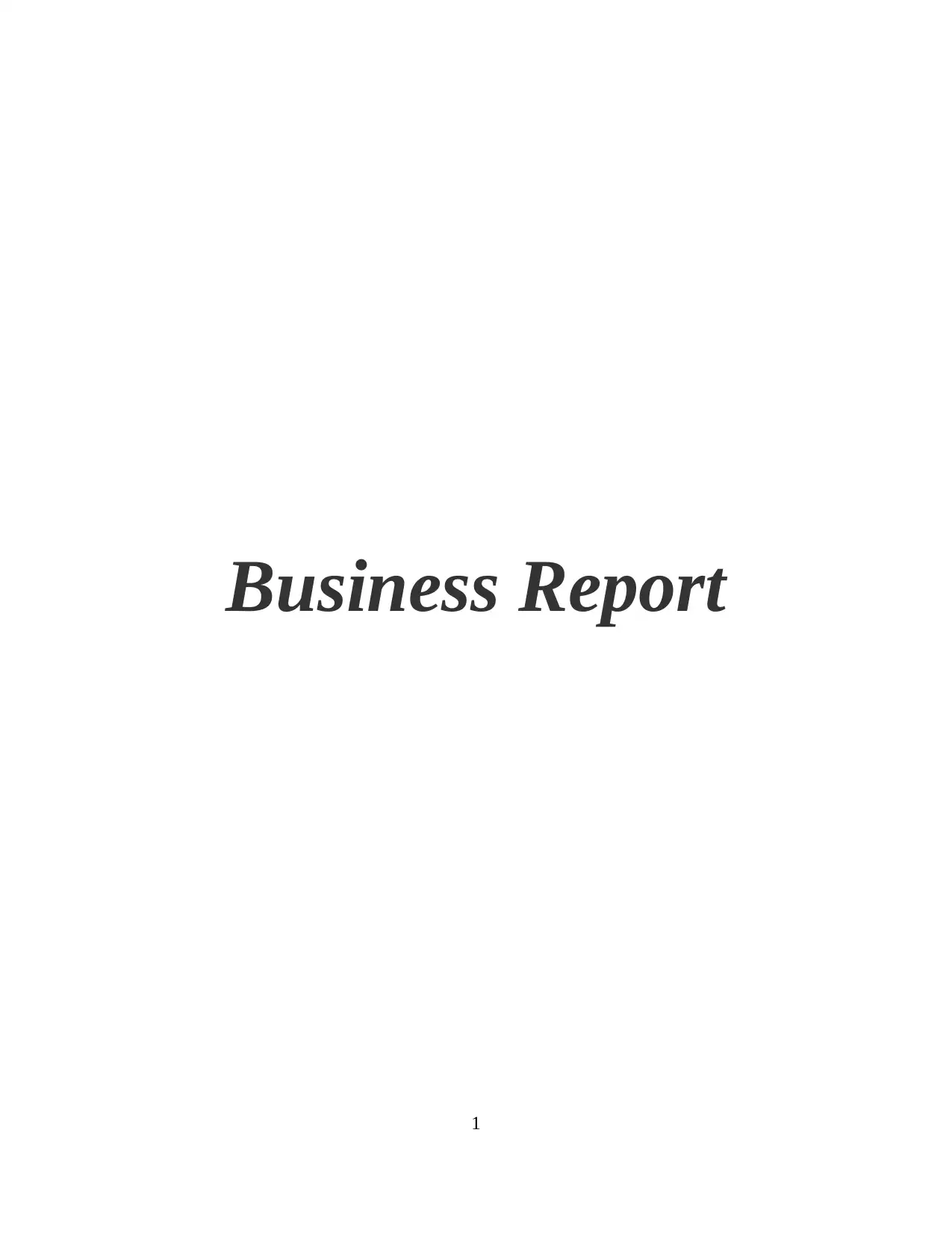
Business Report
1
1
Secure Best Marks with AI Grader
Need help grading? Try our AI Grader for instant feedback on your assignments.
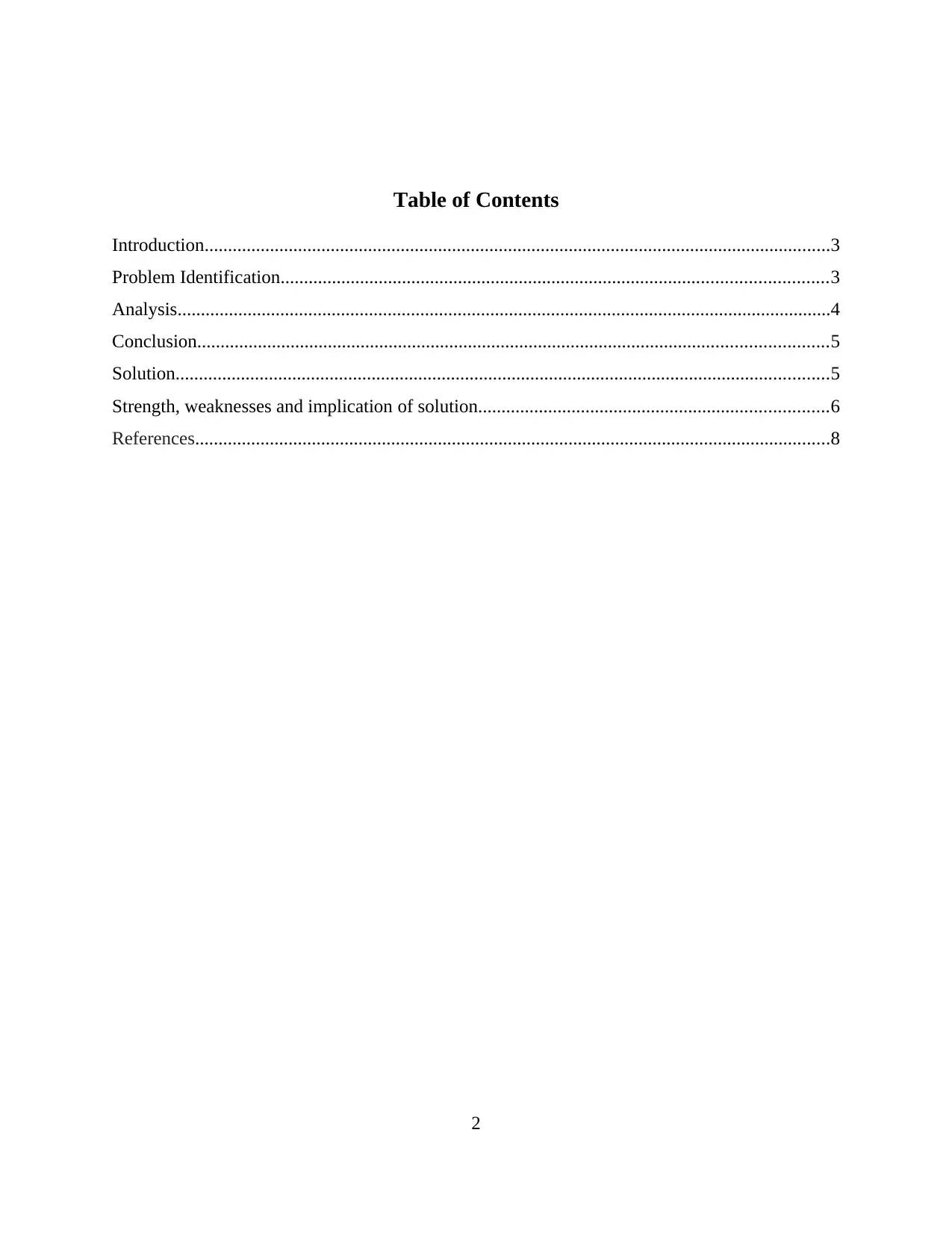
Table of Contents
Introduction......................................................................................................................................3
Problem Identification.....................................................................................................................3
Analysis............................................................................................................................................4
Conclusion.......................................................................................................................................5
Solution............................................................................................................................................5
Strength, weaknesses and implication of solution...........................................................................6
References........................................................................................................................................8
2
Introduction......................................................................................................................................3
Problem Identification.....................................................................................................................3
Analysis............................................................................................................................................4
Conclusion.......................................................................................................................................5
Solution............................................................................................................................................5
Strength, weaknesses and implication of solution...........................................................................6
References........................................................................................................................................8
2
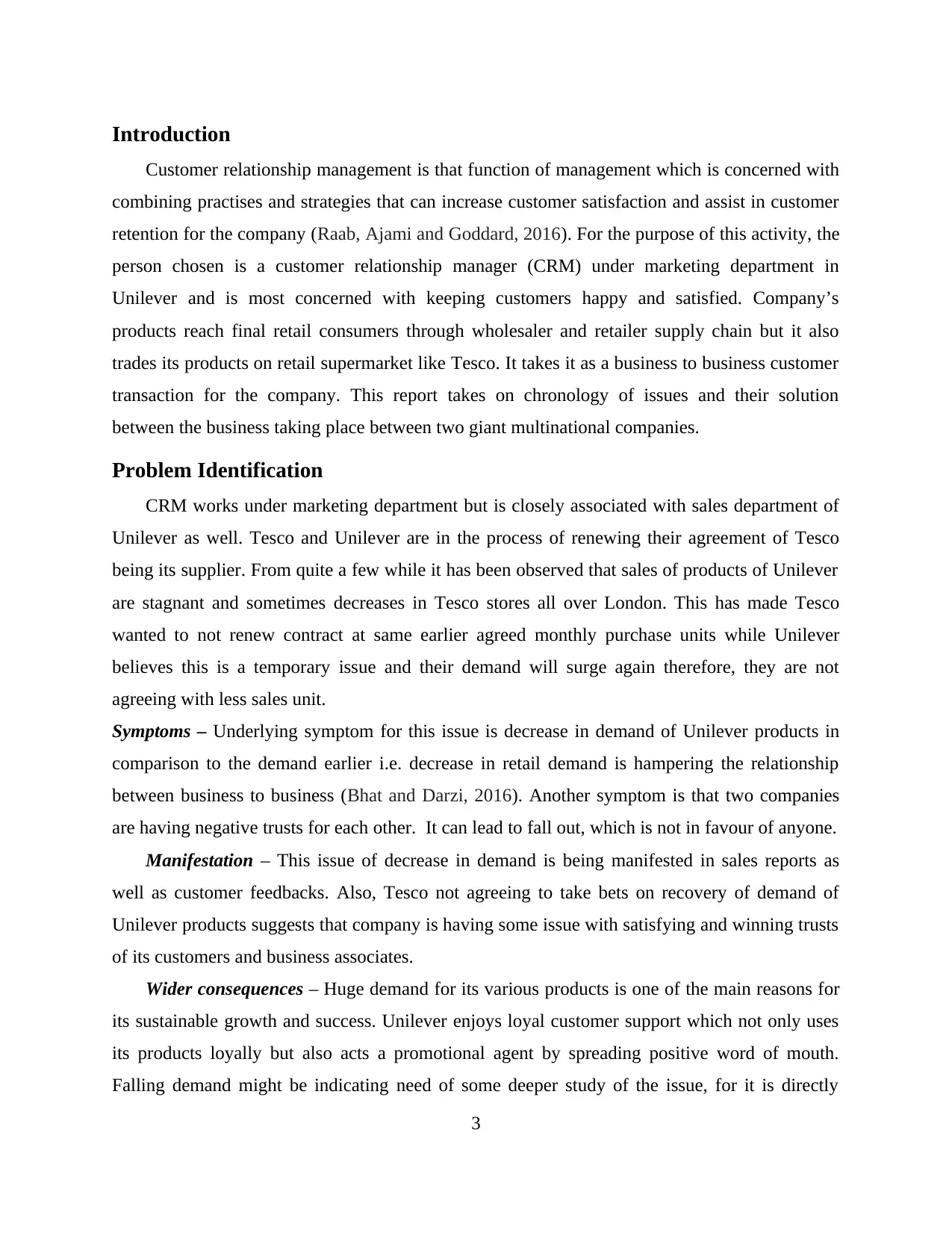
Introduction
Customer relationship management is that function of management which is concerned with
combining practises and strategies that can increase customer satisfaction and assist in customer
retention for the company (Raab, Ajami and Goddard, 2016). For the purpose of this activity, the
person chosen is a customer relationship manager (CRM) under marketing department in
Unilever and is most concerned with keeping customers happy and satisfied. Company’s
products reach final retail consumers through wholesaler and retailer supply chain but it also
trades its products on retail supermarket like Tesco. It takes it as a business to business customer
transaction for the company. This report takes on chronology of issues and their solution
between the business taking place between two giant multinational companies.
Problem Identification
CRM works under marketing department but is closely associated with sales department of
Unilever as well. Tesco and Unilever are in the process of renewing their agreement of Tesco
being its supplier. From quite a few while it has been observed that sales of products of Unilever
are stagnant and sometimes decreases in Tesco stores all over London. This has made Tesco
wanted to not renew contract at same earlier agreed monthly purchase units while Unilever
believes this is a temporary issue and their demand will surge again therefore, they are not
agreeing with less sales unit.
Symptoms – Underlying symptom for this issue is decrease in demand of Unilever products in
comparison to the demand earlier i.e. decrease in retail demand is hampering the relationship
between business to business (Bhat and Darzi, 2016). Another symptom is that two companies
are having negative trusts for each other. It can lead to fall out, which is not in favour of anyone.
Manifestation – This issue of decrease in demand is being manifested in sales reports as
well as customer feedbacks. Also, Tesco not agreeing to take bets on recovery of demand of
Unilever products suggests that company is having some issue with satisfying and winning trusts
of its customers and business associates.
Wider consequences – Huge demand for its various products is one of the main reasons for
its sustainable growth and success. Unilever enjoys loyal customer support which not only uses
its products loyally but also acts a promotional agent by spreading positive word of mouth.
Falling demand might be indicating need of some deeper study of the issue, for it is directly
3
Customer relationship management is that function of management which is concerned with
combining practises and strategies that can increase customer satisfaction and assist in customer
retention for the company (Raab, Ajami and Goddard, 2016). For the purpose of this activity, the
person chosen is a customer relationship manager (CRM) under marketing department in
Unilever and is most concerned with keeping customers happy and satisfied. Company’s
products reach final retail consumers through wholesaler and retailer supply chain but it also
trades its products on retail supermarket like Tesco. It takes it as a business to business customer
transaction for the company. This report takes on chronology of issues and their solution
between the business taking place between two giant multinational companies.
Problem Identification
CRM works under marketing department but is closely associated with sales department of
Unilever as well. Tesco and Unilever are in the process of renewing their agreement of Tesco
being its supplier. From quite a few while it has been observed that sales of products of Unilever
are stagnant and sometimes decreases in Tesco stores all over London. This has made Tesco
wanted to not renew contract at same earlier agreed monthly purchase units while Unilever
believes this is a temporary issue and their demand will surge again therefore, they are not
agreeing with less sales unit.
Symptoms – Underlying symptom for this issue is decrease in demand of Unilever products in
comparison to the demand earlier i.e. decrease in retail demand is hampering the relationship
between business to business (Bhat and Darzi, 2016). Another symptom is that two companies
are having negative trusts for each other. It can lead to fall out, which is not in favour of anyone.
Manifestation – This issue of decrease in demand is being manifested in sales reports as
well as customer feedbacks. Also, Tesco not agreeing to take bets on recovery of demand of
Unilever products suggests that company is having some issue with satisfying and winning trusts
of its customers and business associates.
Wider consequences – Huge demand for its various products is one of the main reasons for
its sustainable growth and success. Unilever enjoys loyal customer support which not only uses
its products loyally but also acts a promotional agent by spreading positive word of mouth.
Falling demand might be indicating need of some deeper study of the issue, for it is directly
3
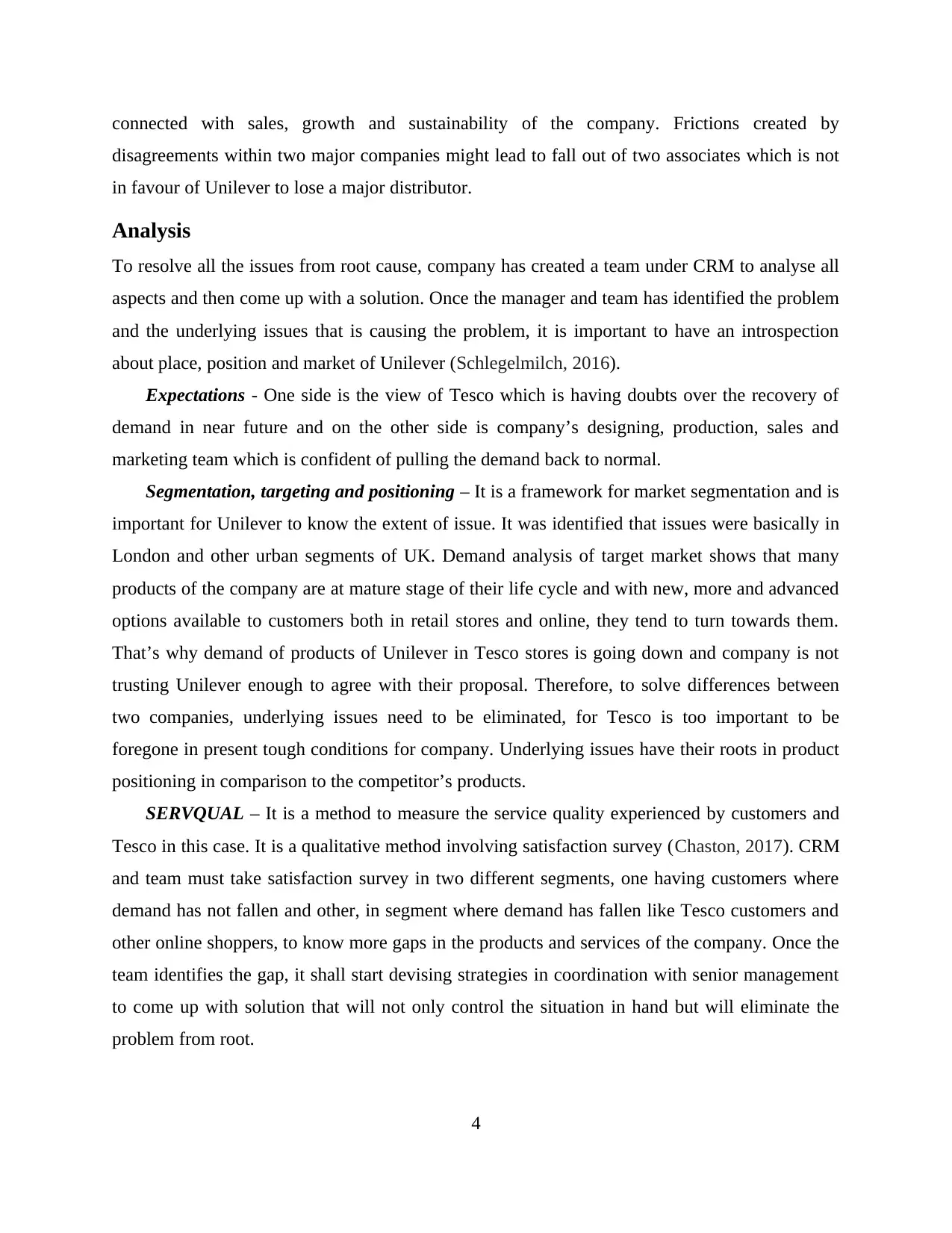
connected with sales, growth and sustainability of the company. Frictions created by
disagreements within two major companies might lead to fall out of two associates which is not
in favour of Unilever to lose a major distributor.
Analysis
To resolve all the issues from root cause, company has created a team under CRM to analyse all
aspects and then come up with a solution. Once the manager and team has identified the problem
and the underlying issues that is causing the problem, it is important to have an introspection
about place, position and market of Unilever (Schlegelmilch, 2016).
Expectations - One side is the view of Tesco which is having doubts over the recovery of
demand in near future and on the other side is company’s designing, production, sales and
marketing team which is confident of pulling the demand back to normal.
Segmentation, targeting and positioning – It is a framework for market segmentation and is
important for Unilever to know the extent of issue. It was identified that issues were basically in
London and other urban segments of UK. Demand analysis of target market shows that many
products of the company are at mature stage of their life cycle and with new, more and advanced
options available to customers both in retail stores and online, they tend to turn towards them.
That’s why demand of products of Unilever in Tesco stores is going down and company is not
trusting Unilever enough to agree with their proposal. Therefore, to solve differences between
two companies, underlying issues need to be eliminated, for Tesco is too important to be
foregone in present tough conditions for company. Underlying issues have their roots in product
positioning in comparison to the competitor’s products.
SERVQUAL – It is a method to measure the service quality experienced by customers and
Tesco in this case. It is a qualitative method involving satisfaction survey (Chaston, 2017). CRM
and team must take satisfaction survey in two different segments, one having customers where
demand has not fallen and other, in segment where demand has fallen like Tesco customers and
other online shoppers, to know more gaps in the products and services of the company. Once the
team identifies the gap, it shall start devising strategies in coordination with senior management
to come up with solution that will not only control the situation in hand but will eliminate the
problem from root.
4
disagreements within two major companies might lead to fall out of two associates which is not
in favour of Unilever to lose a major distributor.
Analysis
To resolve all the issues from root cause, company has created a team under CRM to analyse all
aspects and then come up with a solution. Once the manager and team has identified the problem
and the underlying issues that is causing the problem, it is important to have an introspection
about place, position and market of Unilever (Schlegelmilch, 2016).
Expectations - One side is the view of Tesco which is having doubts over the recovery of
demand in near future and on the other side is company’s designing, production, sales and
marketing team which is confident of pulling the demand back to normal.
Segmentation, targeting and positioning – It is a framework for market segmentation and is
important for Unilever to know the extent of issue. It was identified that issues were basically in
London and other urban segments of UK. Demand analysis of target market shows that many
products of the company are at mature stage of their life cycle and with new, more and advanced
options available to customers both in retail stores and online, they tend to turn towards them.
That’s why demand of products of Unilever in Tesco stores is going down and company is not
trusting Unilever enough to agree with their proposal. Therefore, to solve differences between
two companies, underlying issues need to be eliminated, for Tesco is too important to be
foregone in present tough conditions for company. Underlying issues have their roots in product
positioning in comparison to the competitor’s products.
SERVQUAL – It is a method to measure the service quality experienced by customers and
Tesco in this case. It is a qualitative method involving satisfaction survey (Chaston, 2017). CRM
and team must take satisfaction survey in two different segments, one having customers where
demand has not fallen and other, in segment where demand has fallen like Tesco customers and
other online shoppers, to know more gaps in the products and services of the company. Once the
team identifies the gap, it shall start devising strategies in coordination with senior management
to come up with solution that will not only control the situation in hand but will eliminate the
problem from root.
4
Secure Best Marks with AI Grader
Need help grading? Try our AI Grader for instant feedback on your assignments.
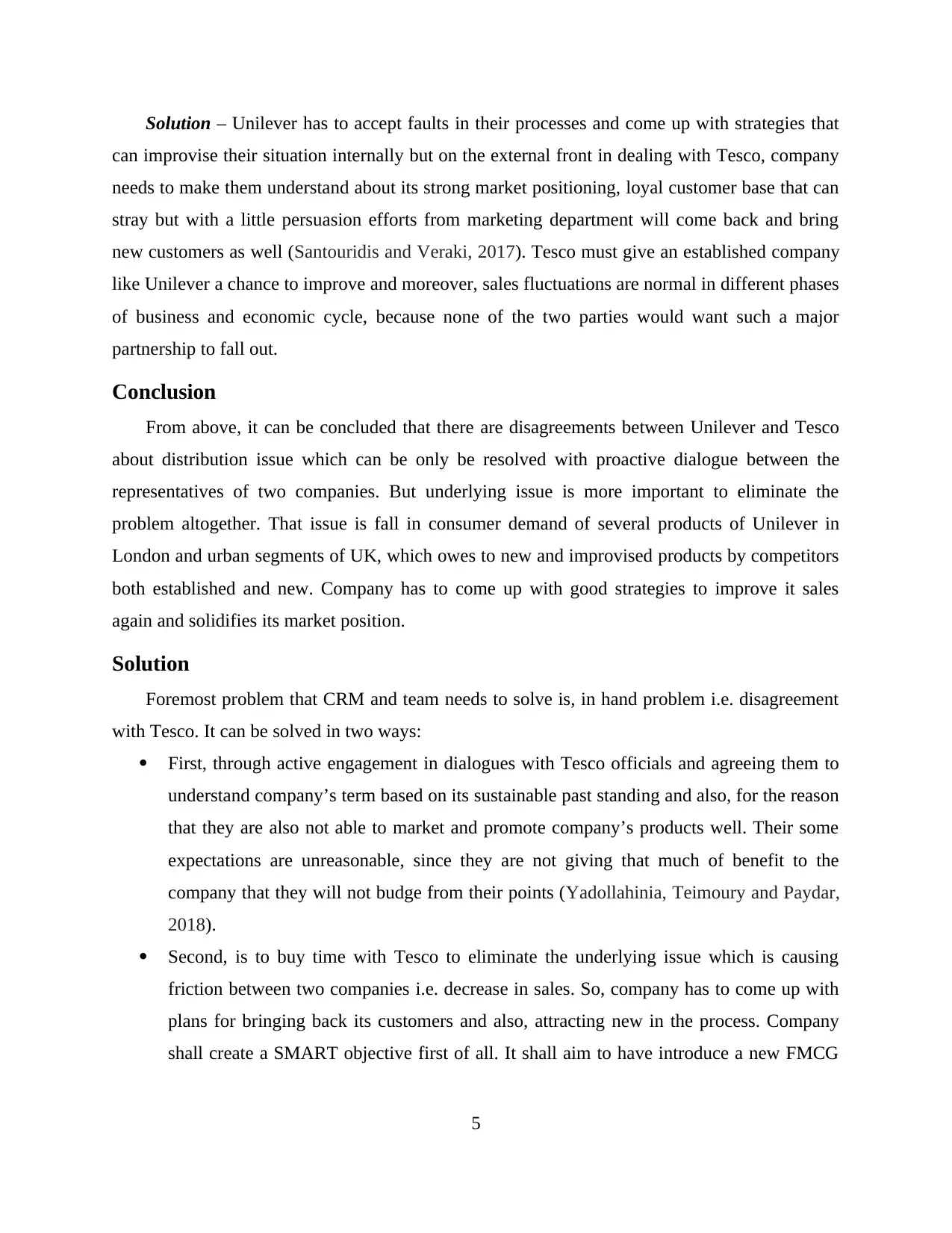
Solution – Unilever has to accept faults in their processes and come up with strategies that
can improvise their situation internally but on the external front in dealing with Tesco, company
needs to make them understand about its strong market positioning, loyal customer base that can
stray but with a little persuasion efforts from marketing department will come back and bring
new customers as well (Santouridis and Veraki, 2017). Tesco must give an established company
like Unilever a chance to improve and moreover, sales fluctuations are normal in different phases
of business and economic cycle, because none of the two parties would want such a major
partnership to fall out.
Conclusion
From above, it can be concluded that there are disagreements between Unilever and Tesco
about distribution issue which can be only be resolved with proactive dialogue between the
representatives of two companies. But underlying issue is more important to eliminate the
problem altogether. That issue is fall in consumer demand of several products of Unilever in
London and urban segments of UK, which owes to new and improvised products by competitors
both established and new. Company has to come up with good strategies to improve it sales
again and solidifies its market position.
Solution
Foremost problem that CRM and team needs to solve is, in hand problem i.e. disagreement
with Tesco. It can be solved in two ways:
First, through active engagement in dialogues with Tesco officials and agreeing them to
understand company’s term based on its sustainable past standing and also, for the reason
that they are also not able to market and promote company’s products well. Their some
expectations are unreasonable, since they are not giving that much of benefit to the
company that they will not budge from their points (Yadollahinia, Teimoury and Paydar,
2018).
Second, is to buy time with Tesco to eliminate the underlying issue which is causing
friction between two companies i.e. decrease in sales. So, company has to come up with
plans for bringing back its customers and also, attracting new in the process. Company
shall create a SMART objective first of all. It shall aim to have introduce a new FMCG
5
can improvise their situation internally but on the external front in dealing with Tesco, company
needs to make them understand about its strong market positioning, loyal customer base that can
stray but with a little persuasion efforts from marketing department will come back and bring
new customers as well (Santouridis and Veraki, 2017). Tesco must give an established company
like Unilever a chance to improve and moreover, sales fluctuations are normal in different phases
of business and economic cycle, because none of the two parties would want such a major
partnership to fall out.
Conclusion
From above, it can be concluded that there are disagreements between Unilever and Tesco
about distribution issue which can be only be resolved with proactive dialogue between the
representatives of two companies. But underlying issue is more important to eliminate the
problem altogether. That issue is fall in consumer demand of several products of Unilever in
London and urban segments of UK, which owes to new and improvised products by competitors
both established and new. Company has to come up with good strategies to improve it sales
again and solidifies its market position.
Solution
Foremost problem that CRM and team needs to solve is, in hand problem i.e. disagreement
with Tesco. It can be solved in two ways:
First, through active engagement in dialogues with Tesco officials and agreeing them to
understand company’s term based on its sustainable past standing and also, for the reason
that they are also not able to market and promote company’s products well. Their some
expectations are unreasonable, since they are not giving that much of benefit to the
company that they will not budge from their points (Yadollahinia, Teimoury and Paydar,
2018).
Second, is to buy time with Tesco to eliminate the underlying issue which is causing
friction between two companies i.e. decrease in sales. So, company has to come up with
plans for bringing back its customers and also, attracting new in the process. Company
shall create a SMART objective first of all. It shall aim to have introduce a new FMCG
5
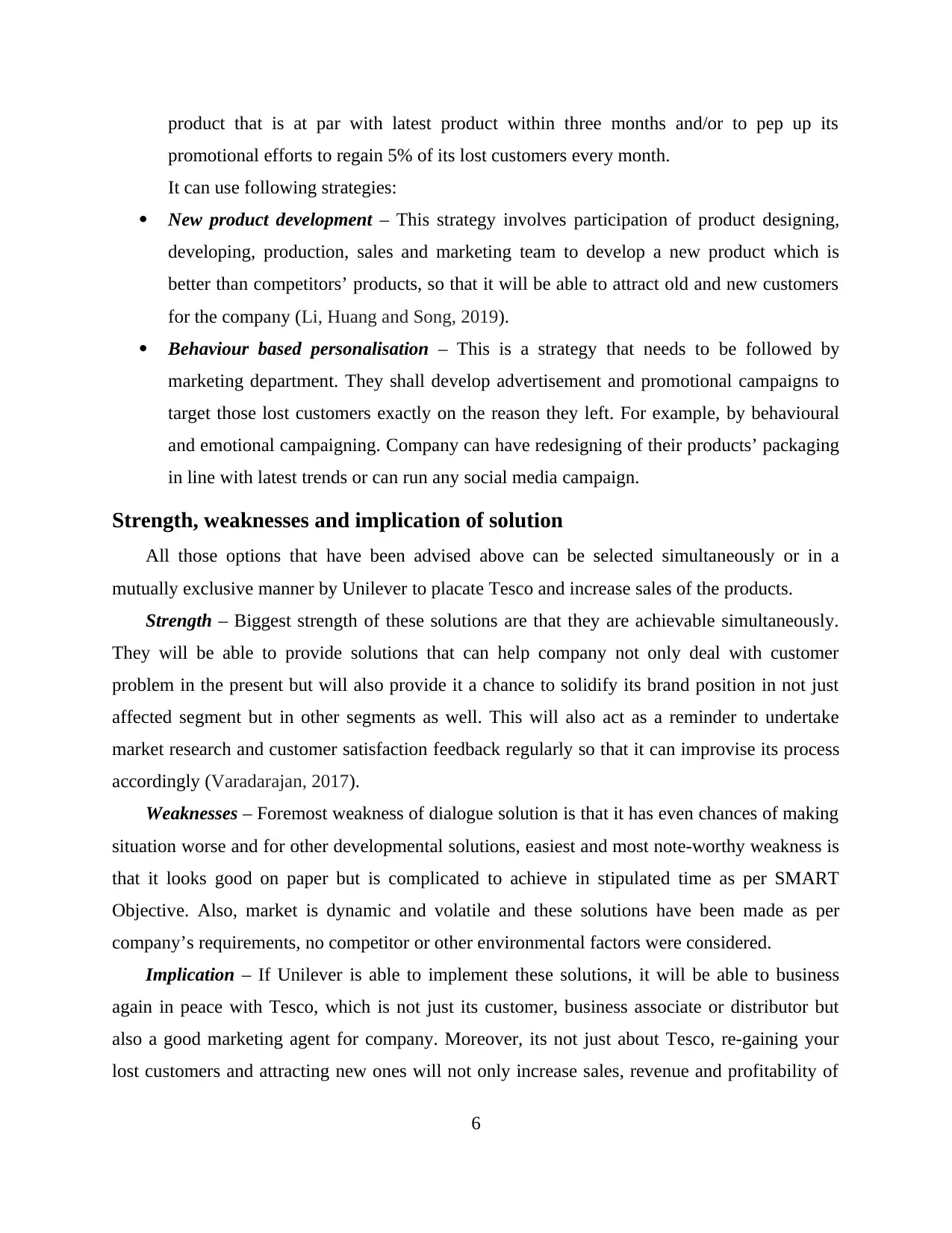
product that is at par with latest product within three months and/or to pep up its
promotional efforts to regain 5% of its lost customers every month.
It can use following strategies:
New product development – This strategy involves participation of product designing,
developing, production, sales and marketing team to develop a new product which is
better than competitors’ products, so that it will be able to attract old and new customers
for the company (Li, Huang and Song, 2019).
Behaviour based personalisation – This is a strategy that needs to be followed by
marketing department. They shall develop advertisement and promotional campaigns to
target those lost customers exactly on the reason they left. For example, by behavioural
and emotional campaigning. Company can have redesigning of their products’ packaging
in line with latest trends or can run any social media campaign.
Strength, weaknesses and implication of solution
All those options that have been advised above can be selected simultaneously or in a
mutually exclusive manner by Unilever to placate Tesco and increase sales of the products.
Strength – Biggest strength of these solutions are that they are achievable simultaneously.
They will be able to provide solutions that can help company not only deal with customer
problem in the present but will also provide it a chance to solidify its brand position in not just
affected segment but in other segments as well. This will also act as a reminder to undertake
market research and customer satisfaction feedback regularly so that it can improvise its process
accordingly (Varadarajan, 2017).
Weaknesses – Foremost weakness of dialogue solution is that it has even chances of making
situation worse and for other developmental solutions, easiest and most note-worthy weakness is
that it looks good on paper but is complicated to achieve in stipulated time as per SMART
Objective. Also, market is dynamic and volatile and these solutions have been made as per
company’s requirements, no competitor or other environmental factors were considered.
Implication – If Unilever is able to implement these solutions, it will be able to business
again in peace with Tesco, which is not just its customer, business associate or distributor but
also a good marketing agent for company. Moreover, its not just about Tesco, re-gaining your
lost customers and attracting new ones will not only increase sales, revenue and profitability of
6
promotional efforts to regain 5% of its lost customers every month.
It can use following strategies:
New product development – This strategy involves participation of product designing,
developing, production, sales and marketing team to develop a new product which is
better than competitors’ products, so that it will be able to attract old and new customers
for the company (Li, Huang and Song, 2019).
Behaviour based personalisation – This is a strategy that needs to be followed by
marketing department. They shall develop advertisement and promotional campaigns to
target those lost customers exactly on the reason they left. For example, by behavioural
and emotional campaigning. Company can have redesigning of their products’ packaging
in line with latest trends or can run any social media campaign.
Strength, weaknesses and implication of solution
All those options that have been advised above can be selected simultaneously or in a
mutually exclusive manner by Unilever to placate Tesco and increase sales of the products.
Strength – Biggest strength of these solutions are that they are achievable simultaneously.
They will be able to provide solutions that can help company not only deal with customer
problem in the present but will also provide it a chance to solidify its brand position in not just
affected segment but in other segments as well. This will also act as a reminder to undertake
market research and customer satisfaction feedback regularly so that it can improvise its process
accordingly (Varadarajan, 2017).
Weaknesses – Foremost weakness of dialogue solution is that it has even chances of making
situation worse and for other developmental solutions, easiest and most note-worthy weakness is
that it looks good on paper but is complicated to achieve in stipulated time as per SMART
Objective. Also, market is dynamic and volatile and these solutions have been made as per
company’s requirements, no competitor or other environmental factors were considered.
Implication – If Unilever is able to implement these solutions, it will be able to business
again in peace with Tesco, which is not just its customer, business associate or distributor but
also a good marketing agent for company. Moreover, its not just about Tesco, re-gaining your
lost customers and attracting new ones will not only increase sales, revenue and profitability of
6
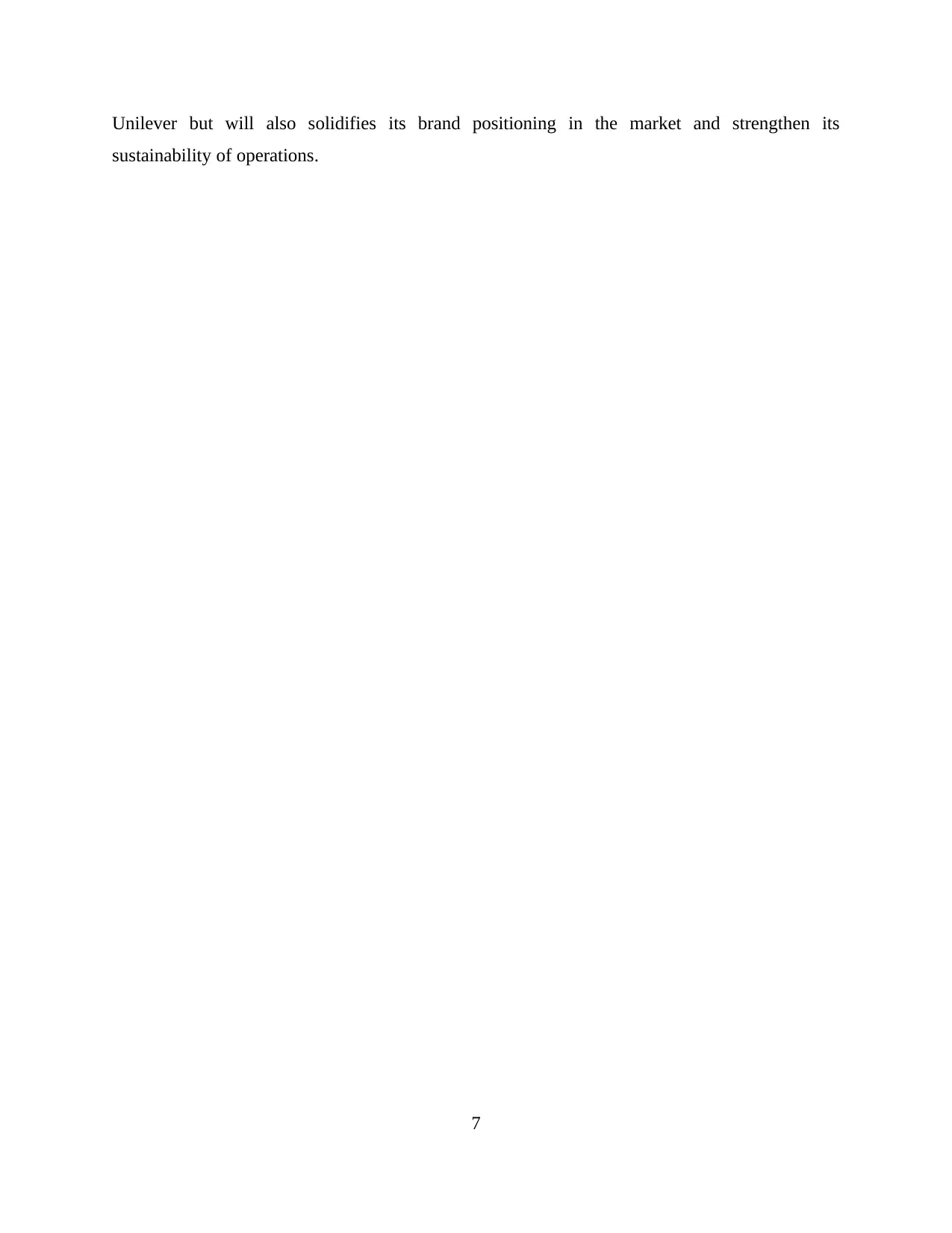
Unilever but will also solidifies its brand positioning in the market and strengthen its
sustainability of operations.
7
sustainability of operations.
7
Paraphrase This Document
Need a fresh take? Get an instant paraphrase of this document with our AI Paraphraser
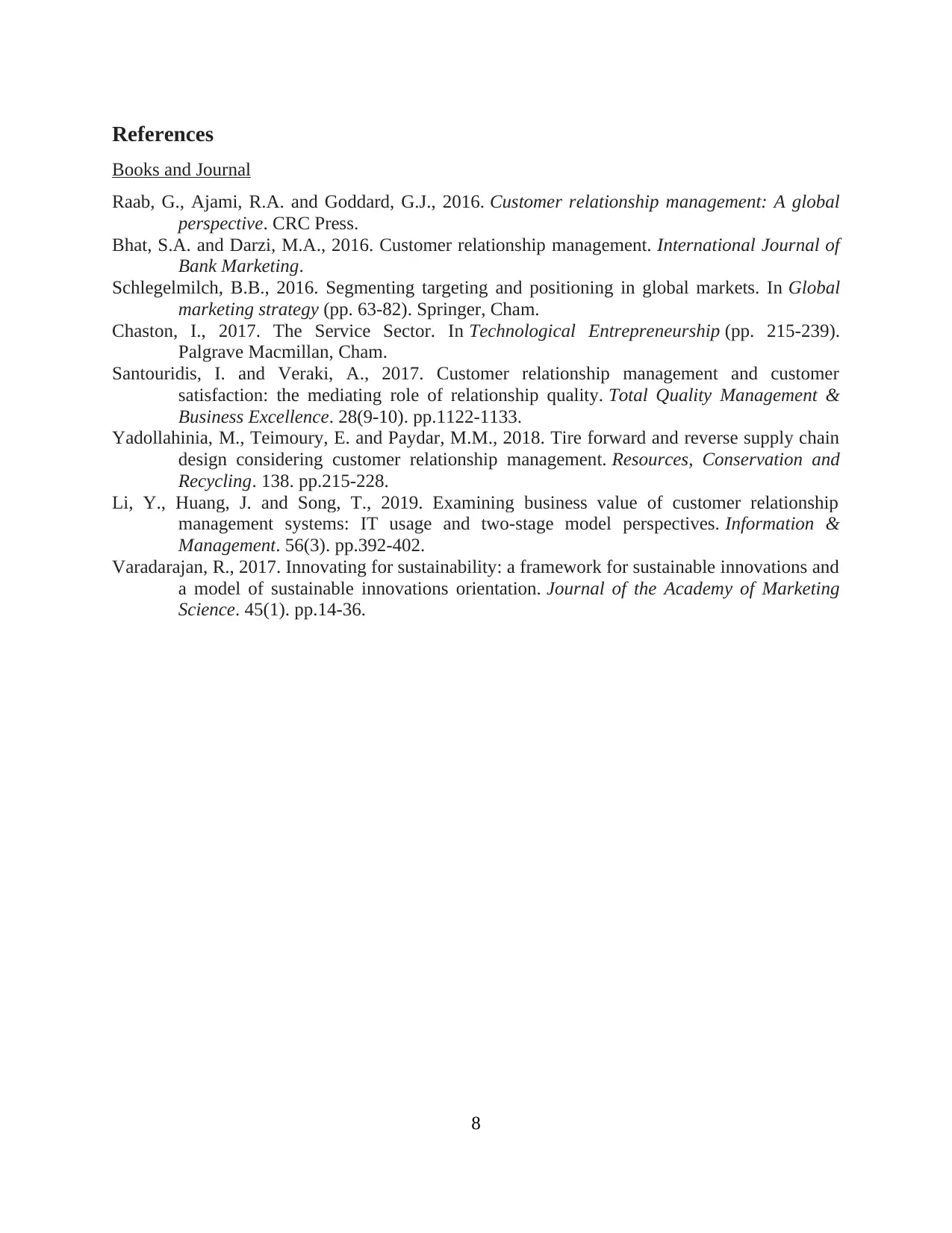
References
Books and Journal
Raab, G., Ajami, R.A. and Goddard, G.J., 2016. Customer relationship management: A global
perspective. CRC Press.
Bhat, S.A. and Darzi, M.A., 2016. Customer relationship management. International Journal of
Bank Marketing.
Schlegelmilch, B.B., 2016. Segmenting targeting and positioning in global markets. In Global
marketing strategy (pp. 63-82). Springer, Cham.
Chaston, I., 2017. The Service Sector. In Technological Entrepreneurship (pp. 215-239).
Palgrave Macmillan, Cham.
Santouridis, I. and Veraki, A., 2017. Customer relationship management and customer
satisfaction: the mediating role of relationship quality. Total Quality Management &
Business Excellence. 28(9-10). pp.1122-1133.
Yadollahinia, M., Teimoury, E. and Paydar, M.M., 2018. Tire forward and reverse supply chain
design considering customer relationship management. Resources, Conservation and
Recycling. 138. pp.215-228.
Li, Y., Huang, J. and Song, T., 2019. Examining business value of customer relationship
management systems: IT usage and two-stage model perspectives. Information &
Management. 56(3). pp.392-402.
Varadarajan, R., 2017. Innovating for sustainability: a framework for sustainable innovations and
a model of sustainable innovations orientation. Journal of the Academy of Marketing
Science. 45(1). pp.14-36.
8
Books and Journal
Raab, G., Ajami, R.A. and Goddard, G.J., 2016. Customer relationship management: A global
perspective. CRC Press.
Bhat, S.A. and Darzi, M.A., 2016. Customer relationship management. International Journal of
Bank Marketing.
Schlegelmilch, B.B., 2016. Segmenting targeting and positioning in global markets. In Global
marketing strategy (pp. 63-82). Springer, Cham.
Chaston, I., 2017. The Service Sector. In Technological Entrepreneurship (pp. 215-239).
Palgrave Macmillan, Cham.
Santouridis, I. and Veraki, A., 2017. Customer relationship management and customer
satisfaction: the mediating role of relationship quality. Total Quality Management &
Business Excellence. 28(9-10). pp.1122-1133.
Yadollahinia, M., Teimoury, E. and Paydar, M.M., 2018. Tire forward and reverse supply chain
design considering customer relationship management. Resources, Conservation and
Recycling. 138. pp.215-228.
Li, Y., Huang, J. and Song, T., 2019. Examining business value of customer relationship
management systems: IT usage and two-stage model perspectives. Information &
Management. 56(3). pp.392-402.
Varadarajan, R., 2017. Innovating for sustainability: a framework for sustainable innovations and
a model of sustainable innovations orientation. Journal of the Academy of Marketing
Science. 45(1). pp.14-36.
8
1 out of 8
Related Documents
Your All-in-One AI-Powered Toolkit for Academic Success.
+13062052269
info@desklib.com
Available 24*7 on WhatsApp / Email
![[object Object]](/_next/static/media/star-bottom.7253800d.svg)
Unlock your academic potential
© 2024 | Zucol Services PVT LTD | All rights reserved.





